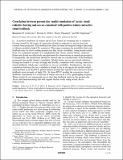Correlation between present-day model simulation of Arctic cloud radiative forcing and sea ice consistent with positive winter convective cloud feedback
Author(s)
Emanuel, Kerry Andrew; Leibowicz, Benjamin D.; Abbot, Dorian S.; Tziperman, Eli
DownloadEmanuel_Correlation between.pdf (6.573Mb)
PUBLISHER_POLICY
Publisher Policy
Article is made available in accordance with the publisher's policy and may be subject to US copyright law. Please refer to the publisher's site for terms of use.
Terms of use
Metadata
Show full item recordAbstract
A positive feedback on winter sea-ice loss, based on warming due to radiative forcing caused by the onset of convective clouds in response to sea-ice loss, has recently been proposed. This feedback has thus far been investigated using a hierarchy of climate models in high CO[subscript 2] scenarios. This paper examines the possibility that such feedback may be active within present-day like Arctic variability, using model output from two reanalysis models. It is emphasized that Arctic surface fluxes, radiative fluxes and clouds are effectively unconstrained by observations in reanalysis products. Consequently, the results here should be viewed only as a model study of the feedback in present-day model climate variability. Model winter sea ice and cloud radiative forcing are found to co-vary strongly and locally, consistent with a strong convective cloud feedback, which may contribute to sea ice variability. Furthermore, the anti-correlation between the two variables is found to be as strong in the model output analyzed here as in the IPCC global climate models that simulate the convective cloud feedback most strongly at high CO[subscript 2]. In those IPCC models the convective cloud feedback contributes to a total loss of winter sea ice in a CO[subscript 2] quadrupling scenario. These results do not necessarily prove that this feedback exists in the present-day Arctic and demonstrating this will require further study using actual Arctic observations.
Date issued
2012-07Department
Massachusetts Institute of Technology. Department of Earth, Atmospheric, and Planetary Sciences; Massachusetts Institute of Technology. Program in Atmospheres, Oceans, and ClimateJournal
Journal of Advances in Modeling Earth Systems
Publisher
American Geophysical Union (AGU)
Citation
Leibowicz, Benjamin D. et al. “Correlation Between Present-day Model Simulation of Arctic Cloud Radiative Forcing and Sea Ice Consistent with Positive Winter Convective Cloud Feedback.” Journal of Advances in Modeling Earth Systems 4 (2012). ©2012 American Geophysical Union
Version: Final published version
ISSN
1942-2466